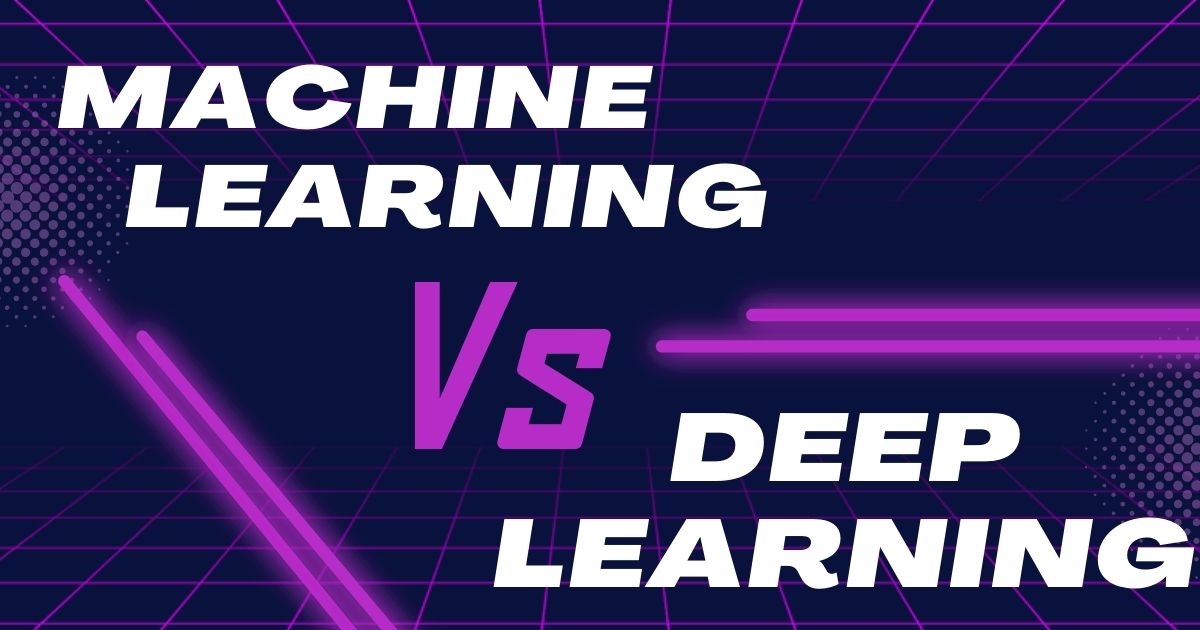Difference Between Machine Learning And Deep Learning : As artificial intelligence (AI) becomes more common in our lives, you might hear the terms “machine learning” (ML) and “deep learning” (DL). While these terms are sometimes used interchangeably, they actually refer to different concepts within AI. This article will explain these differences and help you understand each one better.
Table of Contents
Machine Learning
Machine learning is a type of AI where computers learn from data and make decisions based on it. Think of it as teaching a computer to recognize patterns and make predictions.
Key Points
- Variety of Algorithms:
Machine learning includes many different methods, like:
Supervised Learning: The computer learns from examples that are labeled (e.g., identifying emails as spam or not spam).
Unsupervised Learning: The computer finds patterns in data that isn’t labeled (e.g., grouping customers by purchase behavior).
Reinforcement Learning: The computer learns by making decisions and receiving feedback (e.g., a robot learning to walk). - Feature Engineering:
Humans help the computer by selecting important data features for it to consider. For example, choosing specific characteristics of a house (like size and location) to predict its price. - Data Needs:
Machine learning can work with smaller amounts of data compared to deep learning, but good quality data is still important.
Deep Learning
Deep learning is a specialized type of machine learning that uses neural networks with many layers. These networks are designed to mimic how the human brain works, allowing them to understand more complex data.
Key Points
- Neural Networks:
Deep learning uses networks with many layers to automatically find patterns in data. Two common types are:
Convolutional Neural Networks (CNNs): Used for image recognition.
Recurrent Neural Networks (RNNs): Used for processing sequences, like text or speech. - Automatic Feature Extraction:
Unlike traditional machine learning, deep learning doesn’t need humans to pick out important features. The model learns directly from raw data. - Data and Power Requirements:
Deep learning needs a lot of data and powerful computers to work well. This is because the models are complex and require a lot of computation. - Performance:
Deep learning often performs better with complex tasks involving images, speech, and natural language.
Read More : What Is Deep Learning?
Practical Applications
While both machine learning and deep learning are used in many areas, they are suited to different types of tasks.
Machine Learning :
- Predicting equipment failures in factories.
- Detecting fraud in banking.
- Segmenting customers for marketing.
- Filtering spam in emails.
Deep Learning :
- Recognizing faces in photos.
- Understanding speech in virtual assistants.
- Driving autonomous cars.
- Analyzing medical images to detect diseases.
Machine Learning vs. Deep Learning: Key Differences
| Feature | Machine Learning | Deep Learning |
|---|---|---|
| Definition | A subset of AI where computers learn from data using various algorithms. | A subset of machine learning that uses neural networks with many layers to learn from large amounts of data. |
| Algorithm Types | Includes supervised, unsupervised, and reinforcement learning. | Primarily uses deep neural networks (e.g., CNNs, RNNs). |
| Feature Engineering | Requires manual selection and creation of features by humans. | Automatically extracts features from raw data. |
| Data Requirements | Can work with smaller datasets, though quality is important. | Requires large amounts of data for effective training. |
| Computational Power | Generally less computationally intensive. | Requires significant computational resources, often using GPUs/TPUs. |
| Performance | Effective for a wide range of tasks with structured data. | Excels in tasks involving unstructured data like images, audio, and text. |
| Common Applications | Predictive maintenance, fraud detection, customer segmentation, spam detection. | Image and speech recognition, natural language processing, autonomous driving, medical image analysis. |
| Learning Process | Uses various algorithms and needs some human intervention for feature selection. | Uses deep neural networks and learns directly from data without much human intervention. |
| Complexity | Simpler models with less layers; easier to interpret. | Complex models with many layers; harder to interpret. |
This table highlights the primary differences between machine learning and deep learning, showcasing their unique characteristics, requirements, and applications.
Conclusion
Machine learning and deep learning are both important parts of AI, but they work in different ways. Machine learning includes a range of methods for finding patterns and making predictions, often with some help from humans. Deep learning uses complex neural networks to automatically learn from large amounts of data, making it powerful for more complex tasks. Understanding these differences can help you better appreciate how AI is transforming our world.
FAQ on Machine Learning vs. Deep Learning
1. What is the main difference between machine learning and deep learning?
Machine Learning: Uses various algorithms to learn from data and often needs human help to pick important features.
Deep Learning: Uses neural networks with many layers to learn from large amounts of data automatically, without much human help.
2. What types of algorithms are used?
Machine Learning: Includes methods like linear regression, decision trees, and clustering.
Deep Learning: Primarily uses deep neural networks, such as CNNs for images and RNNs for sequences.
3. How much data do they need?
Machine Learning: Can work with smaller datasets but needs high-quality data.
Deep Learning: Requires a lot of data to train effectively.
4. What about computational power?
Machine Learning: Needs less computational power, can run on standard computers.
Deep Learning: Requires more computational power, often using GPUs or TPUs.
